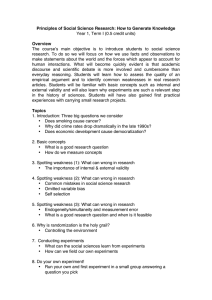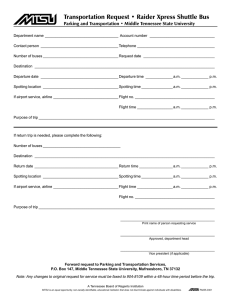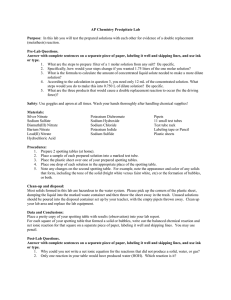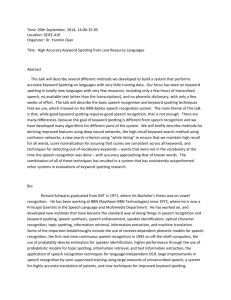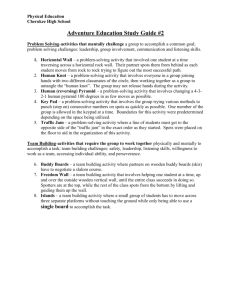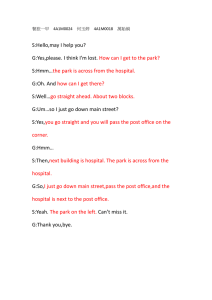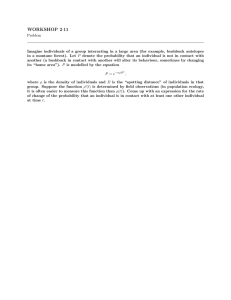Spotting Handwritten Words and REGEX using a two stage BLSTM
advertisement
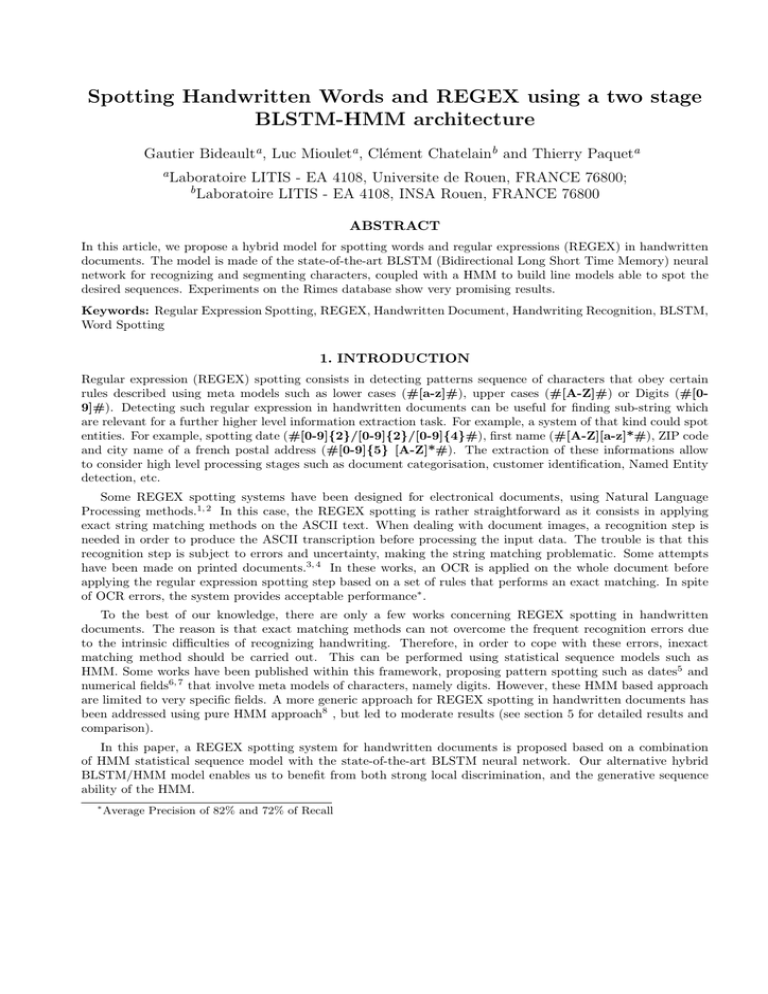
Spotting Handwritten Words and REGEX using a two stage
BLSTM-HMM architecture
Gautier Bideaulta , Luc Miouleta , Clément Chatelainb and Thierry Paqueta
a Laboratoire
LITIS - EA 4108, Universite de Rouen, FRANCE 76800;
LITIS - EA 4108, INSA Rouen, FRANCE 76800
b Laboratoire
ABSTRACT
In this article, we propose a hybrid model for spotting words and regular expressions (REGEX) in handwritten
documents. The model is made of the state-of-the-art BLSTM (Bidirectional Long Short Time Memory) neural
network for recognizing and segmenting characters, coupled with a HMM to build line models able to spot the
desired sequences. Experiments on the Rimes database show very promising results.
Keywords: Regular Expression Spotting, REGEX, Handwritten Document, Handwriting Recognition, BLSTM,
Word Spotting
1. INTRODUCTION
Regular expression (REGEX) spotting consists in detecting patterns sequence of characters that obey certain
rules described using meta models such as lower cases (#[a-z]#), upper cases (#[A-Z]#) or Digits (#[09]#). Detecting such regular expression in handwritten documents can be useful for finding sub-string which
are relevant for a further higher level information extraction task. For example, a system of that kind could spot
entities. For example, spotting date (#[0-9]{2}/[0-9]{2}/[0-9]{4}#), first name (#[A-Z][a-z]*#), ZIP code
and city name of a french postal address (#[0-9]{5} [A-Z]*#). The extraction of these informations allow
to consider high level processing stages such as document categorisation, customer identification, Named Entity
detection, etc.
Some REGEX spotting systems have been designed for electronical documents, using Natural Language
Processing methods.1, 2 In this case, the REGEX spotting is rather straightforward as it consists in applying
exact string matching methods on the ASCII text. When dealing with document images, a recognition step is
needed in order to produce the ASCII transcription before processing the input data. The trouble is that this
recognition step is subject to errors and uncertainty, making the string matching problematic. Some attempts
have been made on printed documents.3, 4 In these works, an OCR is applied on the whole document before
applying the regular expression spotting step based on a set of rules that performs an exact matching. In spite
of OCR errors, the system provides acceptable performance∗ .
To the best of our knowledge, there are only a few works concerning REGEX spotting in handwritten
documents. The reason is that exact matching methods can not overcome the frequent recognition errors due
to the intrinsic difficulties of recognizing handwriting. Therefore, in order to cope with these errors, inexact
matching method should be carried out. This can be performed using statistical sequence models such as
HMM. Some works have been published within this framework, proposing pattern spotting such as dates5 and
numerical fields6, 7 that involve meta models of characters, namely digits. However, these HMM based approach
are limited to very specific fields. A more generic approach for REGEX spotting in handwritten documents has
been addressed using pure HMM approach8 , but led to moderate results (see section 5 for detailed results and
comparison).
In this paper, a REGEX spotting system for handwritten documents is proposed based on a combination
of HMM statistical sequence model with the state-of-the-art BLSTM neural network. Our alternative hybrid
BLSTM/HMM model enables us to benefit from both strong local discrimination, and the generative sequence
ability of the HMM.
∗
Average Precision of 82% and 72% of Recall
This paper is organized as follows: first a review of word and REGEX spotting is given in section 2, then we
present our REGEX spotting system based on a hybrid BLSTM/HMM in section 3. Section 4 is devoted to the
experimental setup and results on both word spotting and regular expression spotting tasks carried out on the
RIMES database.9
2. RELATED WORK
As a REGEX can match sequences with variable length and characters, a REGEX spotting task can be assimilated to a word spotting task where the word belongs to a lexicon which contains all the character string
variations admissible by the REGEX. The less constrained the REGEX, the larger the size of the lexicon. Relaxing those constraints makes the REGEX spotting task more complex especially when considering handwritten
document images. As regular expression spotting shares many aspects in common with word spotting we now
briefly introduce the related works concerning word spotting approaches.
Word spotting in document images has received a lot of attention these last years. Systems proposed in
the literature are divided into two main categories : Image based and recognition based systems. The first
one, also known as query-by-example, operates through the image representation of the keywords.10–14 Such
systems are therefore limited to deal with omni-writer handwriting and require to get an image of the query.
The second kind of approaches, also known as query-by-string methods, deals with the ASCII representation of
the keywords.15–19 Moving from the image representation to the ascii representation of the query is performed
through a recognition stage. These systems are suitable for omni-writer handwriting and can be used with any
string query of any size. In this context, many works have focused on several variants of Hidden Markov Models
(HMMs) to process this intrinsically sequential problem.19
State-of-the-art recognition-based approaches are based on a line of text models.17–19 The line model generally
contains a model of the target word, combined with filler models that describe the out-of-vocabulary words.
For example in Thomas et al.,17 the authors present an alpha-numerical information extraction system on
handwritten unconstrained documents. It relies on a global line modeling allowing a dual representation of the
relevant and the irrelevant information. The acceptation or rejection of the matched keyword is controlled by
the variation of a hyper-parameter in the HMM line model. A similar approach is presented in Fisher et al.18
The line model is made of a left and right filler models surrounding the word model. The acceptation or rejection
of the matched keyword is controlled by a text line score based on the likelihood ratio of the word text line and
the filler text line model. However we know that HMM rely on strong observation independence assumptions
and they perform poorly on high dimensional observations. Moreover, they have low discrimination capabilities
between character classes due to their inherently generative modelization framework.
Recently a new approach based on recurrent neural networks has overcome these shortcomings. Bilateral Long
Short Term Memory (BLSTM) architecture has demonstrated impressive capabilities for omni-writer handwriting recognition.20 Some primary applications of BLSTM to word spotting have also demonstrated promising
results.21, 22 In this system, the BLSTM is combined with the CTC layer which provides character class posterior probabilities. Then a token passing algorithm allows efficient decoding of the spotting line model. Very
interesting results have been reported on the IAM Database21† .
In this paper, we combine the BLSTM-CTC architecture with a HMM based spotting line model. This two
stage architecture is first evaluated for hadnwritten word spotting on the RIMES database. Then we explore
some extensions of the system to Regular Expression spotting (REGEX Spotting). This model is described in
the following section.
3. A TWO STAGE BLSTM-CTC HMM FOR INFORMATION SPOTTING
In this section, we describe our hybrid model for word and REGEX spotting. We first describe the BLSTM-HMM
architecture that has been retained, then we present our word spotting model, based on standard state-of-the-art
word spotting framework. And finally, we propose the adaptation of this model for REGEX spotting.
†
Average Precision of 88.15% and R-precision of 84.34%
3.1 BLSTM-CTC for character recognition and segmentation
The BLSTM-CTC is a complex Recurrent Neural Network able to manage long term dependencies thanks to
its internal buffer structure. Each neuron is specialized to stop a specific character in the input signal. The
recurrent architecture allows each neuron to take account of the previous activated neurons (character), possibly
at multiple time step earlier in the input signal (thus modeling long term dependencies). This typical architecture
allows to take account of character bigrams in addition to the input signal to compute the activation of each
neuron. The BLSTM is composed of two recurrent neural networks with Long Short Term Memory neural units.
The first one processes the data from left to right whereas the second one proceeds in the reverse order. For
each time step, decision is taken combining the two networks output, taking advantage of both left and right
context. Such context is essential to have a certain knowledge of the surounding characters, because in most
cases sequences of letters are constrained by the properties of the lexicon. The outputs of these two networks are
then combined through a Softmax decision layer that provides character posterior probabilities in addition to a
non decision class. This decision stage is called the Connectionist Temporal Classification (CTC)23 that enables
the labelling of unsegmented data.
These networks integrate special neural network units : Long Short Term Memory23 (LSTM). LSTM neurons
is composed of a memory cel, an input and three control gates. Each gates control the memory of the cell, i.e
how a given input will affect the memory (input gates), if a new input should reset the memory cell (forget gate)
and if the memory of the network should be presented to the following neuron (output gate). This system of
control gates allows a very accurate control of the memory cell during the training step. A LSTM layer is fully
recurrent, that is to say, the input and the three gates receive at each instant t the input signal at time t and
the previous outputs (at time (t − 1)).
This architecture has shown very impressive results on challenging data-sets dedicated to word recognition9, 24
due to its efficient classification and segmentation ability. For these reasons, its efficiency to cope with the low
level character identification appears also very promising for handwritten words and REGEX spotting, since
such scenario is less contrained by lexicon properties.
The proposed BLSTM/HMM architecture has been chosen in order to take advantage of both generative and
discriminative frameworks. As shown on Figure 3.1, the input sequence is processed by a BLSTM-CTC network
in order to compte character posterior probabilities at every step. Then the probabilities of each labels are fed
to the HMM stage (using class posteriors in place of the character likelihood computed by Gaussian Mixtures
Models in the traditionnal HMM framework) to perform the alignment of the spotting model. We now describe
the HMM line spotting models which enable us to spot either words (cf section 3.2) or REGEX (cf section 3.3).
Lexicon
Generative stage:
line model
Language Model
HMM
p(c|0)
Local information :
Posteriors probabilities
BLSTM ... BLSTM ... BLSTM
Feature extraction :
Hog
Figure 1. Hybrid structure BLSTM/HMM : Detail of the communication between both stages. The BLSTM/CTC outputs
a posteriori probabilities for HMM decoding.
3.2 Handwritten word spotting model
Our word spotting model describes a line of text that may contain the word to spot. As it is classically proposed
in the literature, it is made of the HMM word model surrounded by filler models that represent any other
sequence of characters. Figure 2 shows an example of a word spotting model for the word ”Madame”. The
space model is directly integrated into the filler. By constraining the whole model, we can locate the word at the
beginning, in the middle or at the end of the line. The filler model is basically an ergodic model made of every
character model. In our problem, we use 99 models corresponding to lower and upper cases, digits, punctuations
and space.
X
F iller
M adame
a
F iller
b
...
sp
Z
X
c
...
Figure 2. HMM line model : Detail of every component of the line model
Decoding a text line is classically achieved using the Viterbi algorithm, the system will outputs the character
sequence with the maximum likelihood P (X|λ). In order to accept the spotted word or reject it, decoding is
generally performed twice: a first pass using the spotting model, and a second pass using a filler model. The
likelihood ratio of the two models serves generally as a score for accepting or rejecting the spotted hypothesis.
Using the BLSTM-CTC architecture, posterior probabilities are computed that can directly serve as a score for
accepting/rejecting the hypothesis, without the need for a filler model. The score of each spotted hypothesis is
computed by the average character posteriors over the number of frames spanning the hypothesis. This score is
then normalised by the number of characters of the spotted word. Doing this, we choose to rely on the strong
discriminative decisions of the BLSTM-CTC and use the HMM only as a sequence model constrained by high
level information such as lexicons and/or language models. The graphical representation of the whole word
spotting system is shown on Figure 3
We now show how this model can be adapted to REGEX spotting.
3.3 Regular expression spotting model
As previously mentionned, REGEX spotting is a generalisation of the word spotting task, the difference is that
the sequences to spot are less constrained and more variable, thus leading to a larger lexicon of admissible
expressions.
In order to cope with REGEX queries, we use the HMM stage to model a regular expression with a stochastic
model of character sequences. Each meta model is an ergodic model of characters implied in the query, e.g,
Final Result :
Position of the word
Madame
Decoding step :
Spotting of the word
Madame
X
F iller
M adame
X
F iller
p(c|0)
BLSTM ... BLSTM ... BLSTM
Local information :
Posteriors probabilities
Feature extraction :
Hog
Figure 3. Hybrid structure BLSTM/HMM : Details of every step of the word spotting task from feature extraction to
position of the word Madame in the sentence.
#[a-z]#
#[0-9]#
1
a
2
9
3
8
...
Digits MetaModel (DG)
#[A-Z]#
A
b
z
c
y
...
B
Z
C
Y
...
Lower Cases MetaModel (LC) Upper Cases MetaModel (UC)
Figure 4. HMM MetaModels
Lower Cases (#[a-z]#), Upper Cases (#[A-Z]#) or Digits (#[0-9]#), as it is the case for the Filler models.
Figure 4 shows examples of meta models for these three examples.
We also need to model the variable length of the queries, which may occurs when using * or + operators
(spotting between 0 and ∞ times a character, or spotting between 1 and ∞ times a character) such as in #[09]+# which stands for any sequence of at least 1 digit. This is simply modeled by allowing auto transitions over
the desired character meta model. Figure 5 shows an example of a model for spotting variable length sequences.
The query taken is the sub-string agr following by an unconstrained sequence of lower cases (#[a-z]*#), in this
example we hope that the system will spot the word agréer correctly.
The following models allow searching for a REGEX at the beginning of a line (#[a-z]*ion#), at the end of
a line ((#le[a-z]*#)), or both (#[A-Z]o[a-z]#). The line model can also only contain meta models dedicated
to spotting sequences of digits of any length, for example (#[0-9]*#) or word beginning by one upper case
character and ending with a sequence of lower cases characters of arbitrary length (#[A-Z][a-z]*#). Here, the
arbitrary length of the sequence unconstrained (*) is controled by the auto-transition probabilities of the meta
model of the HMM.
X
F iller
a
g
r
LC
a
F iller
X
b
z
c
y
...
Figure 5. HMM stage : Spotting of regular expressions #agr[a-z]*# (i.e every word beginning by the sub-string agr
followed by any number of lower case characters)
As the transitions in the HMM meta models are ergodic, the Viterbi alignment will only be driven by the
local classification of BLSTM-CTC. The spotting model depends on its discriminant capacity to feed the higher
HMM stage with accurate information from the local character recognition stage.
The graphical representation of the whole REGEX spotting system is shown on Figure 6.
Finally, the integration of meta models and auto transitions into the line model allows spotting of handwritten
REGEX. Practically, the line model is build on the fly at the time of querying the data-set, by rewriting the
REGEX into a HMM line spotting model. At this time, the ”translation” is manually done, but an automatization
of this task can be performed for industrial purpose.
4. EXPERIMENTS
In this section, we give some details about the implementation of the system, starting with a description of the
preprocessing stage in section 4.1 and the features extraction in section 4.2. The performance of the system are
Final Result :
Position of the word
Madame
Decoding step :
Spotting of the substring
Ma
X
F iller
M
a
LC
F iller
X
p(c|0)
BLSTM ... BLSTM ... BLSTM
Local information :
Posteriors probabilities
Feature extraction :
Hog
Figure 6. Hybrid structure BLSTM/HMM : Details of every step of the REGEX spotting task from feature extraction to
position of the REGEX #Ma[a-z]*# in the sentence.
evaluated using the 2011 RIMES database,25 they are summarized in section 4.3.
4.1 Details of Preprocessing
The preprocessing of images consist in a simple three step image correction over the whole line. First a Sauvola
binarisation by thresholding is applied. Then a deslanting process is carried out according to the following
method: the image is rotated between [−Θ; Θ] and for each angle the histogram of vertical continuous traits HΘ
is measured. Finally, a height normalisation is applied to center the baseline and normalize the heights of the
ascenders and descenders.
4.2 Features Set
Our feature vector is based on Histograms of Oriented Gradient (HOG)26 extracted from windows of 8×64 pixels.
During the extraction, the window is dividing into sub-windows of n×m pixels. For each sub-window a histogram
is computed, representing the distribution of the local intensity gradients (edge direction). The histograms of
every windows are then merged to obtain the final representation of our feature vector representation. We used
8 × 8 non-overlapping sub-windows using 8 directions, this produces a 64 dimensional feature vector.
4.3 Results and discussion
To evaluate the performance of our system, all the experiments have been performed on the RIMES database
used for the 2011 ICDAR handwriting recognition competitions.25 The training database is composed of 1.500
documents, the validation and test sets are composed respectively of 100 documents. In order to evaluate the
spotting system, we compute recall (R) and precision measures (P). To do this, the number of true positives
(TP), false positives (FP), and false negatives (FN) are evaluated for all possible threshold values. From these
values, a recall-precision curve is computed by accumulating these values over all word queries.
R=
TP
TP
P =
TP + FN
TP + FP
(1)
4.3.1 Word spotting results
Word spotting systems are generally evaluated by spotting one word in a collection of documents. We have
decided to evaluate our framework by searching a set of words (a lexicon) at the same time, allowing to deal with
confusion between words.8 Spotting a lexicon of keyword instead of a single word is well-suited for document
categorization.27 We evaluate the performance of our system on lexicon of size 25, 50 and 100 words respectively,
following the same data-set and protocol as in Kessentini et al.8 The recall-precision curves are obtained by
varying the threshold applied on line scores (see section 3.2).
Figure 7 presents the recall-precision curves obtained by our BLSTM-HMM hybrid model for each lexicon (25,
50 and 100). It is compared with the results obtained by the standard HMM method developed in Kessentini et
al.8 As expected, the performance drop when the size of the lexicon increase. The BLSTM/HMM provides very
interesting results, since the mean average precision‡ is greater than 80% for 25-lexicon and 50-lexicon queries.
When compared with the pure HMM approach, results show that adding the discriminative stage has drastically
improve the performance of the whole system. Indeed, we can observe a significant gap of at least 20% between
the mean average precision of the two systems, for each lexicon size. This is certainly due to the fact, that the
local decision of the BLSTM are far more discriminative than Gaussian Mixtures.
Figure 7. Word spotting performance with different lexicons of words
4.3.2 Regular expression results
To evaluate the performance of our system on a regular expression spotting task we performed exactly the same
experiments as in.8 In this study the authors were interested in spotting 4 different REGEX queries corresponding
to the the search for the sub-strings ”effe”, ”pa”, ”com” and ”cha” at the beginning of a word (#effe[a-z]*#,
#pa[a-z]*#, #com[a-z]*#, #cha[a-z]*#). As for word spotting experiments, results of the HMM system
have been added too in order to provide a precise comparison between those systems (cf Figure 8).
A first observation is that the system achieves good performance, since most of the REGEX queries lead
to a mean-average precision of nearly 75%, whereas the queries involve many fewer constraints than for word
spotting. Moreover, our results are far beyond the standard HMM approach. We can observe a gap of more
‡
or break-even point: the point where Recall=Precision
than 40% in the difficult cases (#com[a-z]*#) and (#cha[a-z]*#) and 20% in easier ones (#effe[a-z]*# and
#pa[a-z]*#).
1.0
BLSTM-#cha[a-z]*#
HMM-#cha[a-z]*#
BLSTM-#effe[a-z]*#
HMM-#effe[a-z]*#
BLSTM-#pa[a-z]*#
HMM-#pa[a-z]*#
BLSTM-#com[a-z]*#
HMM-#com[a-z]*#
0.8
Precision
0.6
0.4
0.2
0.0
0.0
0.2
0.4
Rappel
0.6
0.8
1.0
Figure 8. Regular expression spotting performance with different queries (#effe[a-z]*#, #pa[a-z]*#, #com[a-z]*#
and #cha[a-z]*#)
We have also tested less constrained queries, with the search for REGEX containing any sequence of upper
cases characters (#[A-Z]*#), and any sequence of digits (#[0-9]#). This problem is by far more difficult than
the previous queries since the corresponding sequences may have variable contents and lengths. For example the
digit query should detect the sequence ”1” as well as sequence ”0123456789”. Results are presented in Figure 9.
Knowing the difficulty of the problem, the performance are still interesting. Note that digit characters are
not very frequent in the database. An interesting fact is that the Uppercase query can reach interesting precision
scores, whereas the digit query can reach very high recall scores.
5. CONCLUSION
In this paper, we have proposed a hybrid system BLSTM-CTC/HMM able to spot any word of REGEX. We have
shown that the hybrid system exhibits interesting results, even on weakly constrained queries such as the search
for sequences of digits of arbitrary length. We have compared our system for REGEX spotting with some recent
work carried out on the same data-set and using the standard HMM framework. Our approach outperforms this
system by more than 30% on the standard word spotting task and by more than 40% on REGEX spotting. These
very promising results allow to envisage the application of higher level spotting systems such as addresses, named
entities for which a combination of specific markers (keywords and alpha numerical expressions) is generally used
to detect the relevant information.
REFERENCES
[1] Dengel, A. R. and Klein, B., “smartfix: A requirements-driven system for document analysis and understanding,” in [Document Analysis Systems V ], 433–444, Springer (2002).
[2] Holzinger, W., Krüpl, B., and Herzog, M., [Using ontologies for extracting product features from web pages ],
Springer (2006).
#[0-9]*#
#[A-Z]*#
1.0
0.8
Precision
0.6
0.4
0.2
0.0
0.0
0.2
0.4
Rappel
0.6
0.8
1.0
Figure 9. Regular expression spotting performance with upper case sequence (#[A-Z]*#) and number sequence (#[09]#)
[3] Spitz, A., “Using character shape codes for word spotting in document images,” in [In: Proceedings of the
symposium on document analysis and information retrieval ], 382–389 (1995).
[4] .Spitz, A., “Determination of script, language content of document images,” in [IEEE Transactions on
Pattern Analysis and Machine Intelligence ], 19, 235–245 (1997).
[5] Morita, M. E., Sabourin, R., Bortolozzi, F., and Suen, C. Y., “Segmentation and recognition of handwritten
dates: an hmm-mlp hybrid approach.,” IJDAR , 248–262 (2003).
[6] Chatelain, C., Heutte, L., and Paquet, T., “A two-stage outlier rejection strategy for numerical field extraction in handwritten documents,” in [ICPR, Hong Kong, China ], 3, 224–227 (2006).
[7] Chatelain, C., Heutte, L., and Paquet, T., “Recognition-based vs syntax-directed models for numerical field
extraction in handwritten documents,” in [ICFHR, Montreal, Canada ], 6p (2008).
[8] Kessentini, Y., Chatelain, C., and Paquet, T., “Word spotting and regular expression detection in handwritten documents,” in [ICDAR ], (2013).
[9] Grosicki, E. and El Abed, H., “Icdar 2009 handwriting recognition competition,” in [Document Analysis
and Recognition, 2009. ICDAR’09. 10th International Conference on ], 1398–1402, IEEE (2009).
[10] Rath, T. M. and Manmatha, R., “Features for word spotting in historical manuscripts,” in [Document
Analysis and Recognition, 2003. Proceedings. Seventh International Conference on ], 218–222, IEEE (2003).
[11] Cao, H. and Govindaraju, V., “Template-free word spotting in low-quality manuscripts,” in [Proceedings of
the 6th International Conference on Advances in Pattern Recognition ], 135–139 (2007).
[12] Adamek, T., OConnor, N. E., and Smeaton, A. F., “Word matching using single closed contours for indexing handwritten historical documents,” International Journal of Document Analysis and Recognition
(IJDAR) 9(2-4), 153–165 (2007).
[13] Rusinol, M., Aldavert, D., Toledo, R., and Lladós, J., “Browsing heterogeneous document collections by a
segmentation-free word spotting method,” in [Document Analysis and Recognition (ICDAR), 2011 International Conference on ], 63–67, IEEE (2011).
[14] Rodrı́guez-Serrano, J. A., Perronnin, F., Lladós, J., and Sánchez, G., “A similarity measure between vector sequences with application to handwritten word image retrieval,” in [Computer Vision and Pattern
Recognition, 2009. CVPR 2009. IEEE Conference on ], 1722–1729, IEEE (2009).
[15] Rodrı́guez-Serrano, J. A. and Perronnin, F., “Handwritten word-spotting using hidden markov models and
universal vocabularies,” Pattern Recognition 42(9), 2106–2116 (2009).
[16] Frinken, V., Fischer, A., Manmatha, R., and Bunke, H., “A novel word spotting method based on recurrent
neural networks,” Pattern Analysis and Machine Intelligence, IEEE Transactions on 34(2), 211–224 (2012).
[17] Thomas, S., Chatelain, C., Heutte, L., and Paquet, T., “An information extraction model for unconstrained
handwritten documents,” in [Pattern Recognition (ICPR), 2010 20th International Conference on ], 3412–
3415, IEEE (2010).
[18] Fischer, A., Keller, A., Frinken, V., and Bunke, H., “Lexicon-free handwritten word spotting using character
hmms,” Pattern Recognition Letters 33(7), 934–942 (2012).
[19] Wshah, S., Kumar, G., and Govindaraju, V., “Script independent word spotting in offline handwritten
documents based on hidden markov models,” in [Frontiers in Handwriting Recognition (ICFHR), 2012
International Conference on ], 14–19, IEEE (2012).
[20] Graves, A., Liwicki, M., Bunke, H., Schmidhuber, J., and Fernández, S., “Unconstrained on-line handwriting
recognition with recurrent neural networks,” in [Advances in Neural Information Processing Systems ], 577–
584 (2008).
[21] Frinken, V., Fischer, A., and Bunke, H., “A novel word spotting algorithm using bidirectional long shortterm memory neural networks,” in [Artificial Neural Networks in Pattern Recognition ], Schwenker, F. and
El Gayar, N., eds., Lecture Notes in Computer Science 5998, 185–196, Springer Berlin Heidelberg (2010).
[22] Wöllmer, M., Eyben, F., Graves, A., Schuller, B., and Rigoll, G., “A tandem blstm-dbn architecture for
keyword spotting with enhanced context modeling,” in [Proc. of NOLISP ], (2009).
[23] Graves, A., Fernández, S., Gomez, F., and Schmidhuber, J., “Connectionist temporal classification: labelling
unsegmented sequence data with recurrent neural networks,” in [Proceedings of the 23rd international conference on Machine learning ], 369–376, ACM (2006).
[24] Graves, A., Liwicki, M., Fernández, S., Bertolami, R., Bunke, H., and Schmidhuber, J., “A novel connectionist system for unconstrained handwriting recognition,” Pattern Analysis and Machine Intelligence,
IEEE Transactions on 31(5), 855–868 (2009).
[25] Grosicki, E. and El-Abed, H., “Icdar 2011-french handwriting recognition competition,” in [Document Analysis and Recognition (ICDAR), 2011 International Conference on ], 1459–1463, IEEE (2011).
[26] Rodrıguez, J. A. and Perronnin, F., “Local gradient histogram features for word spotting in unconstrained
handwritten documents,” in [Int. Conf. on Frontiers in Handwriting Recognition ], (2008).
[27] Paquet, T., Heutte, L., Koch, G., and Chatelain, C., “A categorization system for handwritten documents,”
International Journal on Document Analysis and Recognition 15(4), 315–330 (2012).
